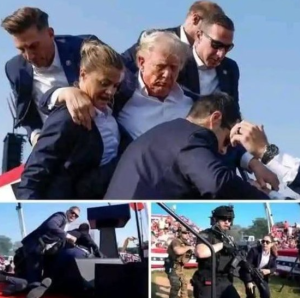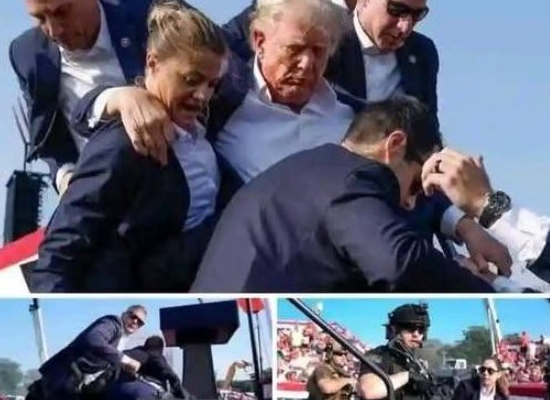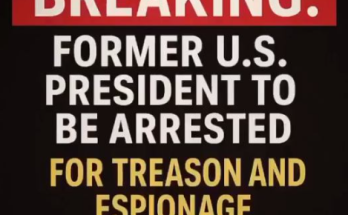The claim that President Donald Trump was “shot again” while exiting the White House has spread quickly across social media, sparking shock and confusion. However, after careful review of credible news sources, official statements, and verifiable timelines, there is no evidence to support that such an event took place in recent hours. What’s unfolding is a classic example of how sensational misinformation circulates online, often blending real past events with fabricated or misleading details.
To understand why this claim feels so believable to some, it’s important to look back at Trump’s recent history with security incidents. On July 13, 2024, during a campaign rally in Butler, Pennsylvania, Trump was indeed injured in a shooting. The gunman, identified as Thomas Matthew Crooks, fired from a rooftop near the rally site. A bullet grazed Trump’s right ear, killing one spectator and critically injuring two others before the attacker was neutralized by the U.S. Secret Service. That event was heavily documented, with photos and videos of Trump being rushed off stage, his face streaked with blood, later becoming iconic. The rally attack dominated headlines for weeks, leading to both public outrage and intense debate over political violence in the United States.
Following the July 2024 attack, investigations by the FBI and congressional committees revealed troubling lapses in security measures. Reports pointed to delayed threat detection, inadequate rooftop surveillance, and communication breakdowns within the protective detail. As a result, new security protocols were introduced, including expanded perimeters, more advanced scanning technology, and stricter crowd management at presidential events. This high-profile event remains fresh in the public memory, making any similar-sounding claim about Trump instantly feel plausible — even without evidence.
More recently, in early March 2025, there was another security-related incident near the White House, though it had nothing to do with Trump being harmed. According to the Secret Service, agents confronted an armed individual near the perimeter of the White House complex. The person reportedly ignored commands to drop their weapon and was subsequently shot by agents. Trump was not in Washington at the time; he was in Florida. While the location and timing of this event made headlines, it was not an assassination attempt, nor did it involve any injuries to the president. Nevertheless, some misleading posts on social media framed it as a “White House shooting” connected to Trump, planting the seeds for later rumors.
The current viral claim seems to fuse these two separate realities: the July 2024 rally shooting and the March 2025 armed encounter near the White House. Social media posts circulate a dramatic image showing Trump surrounded by security agents, which in reality is likely from the Pennsylvania incident or another unrelated moment of heightened protection. By pairing such a photo with the words “shot again” and “White House,” the post creates a narrative that feels urgent and shocking, even though no credible source has confirmed it.
Misinformation of this type spreads for several reasons. First, there’s the emotional impact. The idea of a sitting or former president being shot is inherently dramatic and newsworthy, so people are more likely to share it instantly without verifying. Second, the political climate in the U.S. remains deeply polarized, and stories about Trump — whether positive or negative — tend to attract large audiences. Third, the availability of authentic-looking images from past events makes it easy for bad actors or careless posters to create convincing but false stories.
The problem is that such misinformation doesn’t just cause confusion; it can also inflame political tensions and erode trust in legitimate news sources. When people repeatedly encounter stories that sound plausible but turn out to be false, they may begin doubting all reports, including accurate ones. In the case of security incidents involving high-profile figures, false claims can also create unnecessary panic and even distract law enforcement or emergency services from actual threats.
To verify any claim of this magnitude, it’s essential to check official channels first. The U.S. Secret Service, the White House press office, and major reputable outlets like the Associated Press, Reuters, and major TV networks typically release updates within minutes of a real event. As of this writing, none of these have reported any new shooting involving Donald Trump. In fact, no D.C. police bulletins, hospital admissions reports, or eyewitness accounts from verified journalists support the idea that Trump was harmed today.
The responsibility doesn’t rest only with journalists and officials — individual internet users also play a role. Before sharing or reacting to sensational headlines, it’s worth taking a moment to reverse-image search photos, check the publication date of similar stories, and see whether multiple reputable outlets are covering the same incident. If a story is only appearing on unknown websites or heavily partisan social media accounts, that’s a red flag.
Looking ahead, experts on political security warn that as the 2024 election aftermath continues to ripple into 2025 and beyond, both real threats and fabricated ones will likely surface. Political figures on both sides may face increased risks, and the spread of false information about such threats could be weaponized to influence public perception or undermine trust in institutions.
For Trump specifically, his visibility, polarizing persona, and recent rally shooting make him an especially common target for both real attacks and fake news. Each new false report about his safety doesn’t just mislead the public — it also complicates the work of his protective detail, as they must monitor the fallout from such stories while staying focused on actual risks.
In conclusion, there is no verified evidence that President Donald Trump was shot again while exiting the White House. This story appears to be an unfounded rumor blending elements from two separate, documented events: the July 2024 rally shooting in Pennsylvania and the March 2025 armed confrontation near the White House. The combination of these events, paired with dramatic imagery, has fueled the spread of a false narrative. Until and unless official statements confirm otherwise, this claim should be regarded as untrue. Staying vigilant about the sources of information we consume and share is the best defense against being misled by such sensational but unfounded stories.



